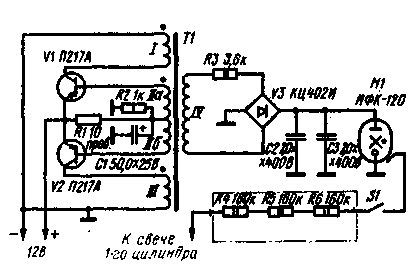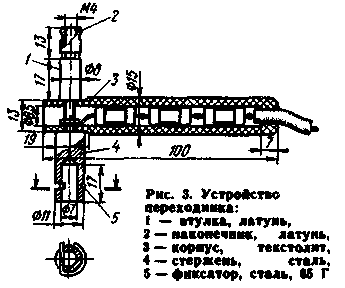Device for setting the ignition timing. Encyclopedia of radio electronics and electrical engineering

Encyclopedia of radio electronics and electrical engineering / Automobile. Ignition
 Comments on the article
Comments on the article
 Accurate setting of the moment of ignition of the combustible mixture in the cylinders of a car engine is a painstaking process that requires a certain skill and a lot of time. The device described below allows you to quickly and easily perform this operation in any conditions.
Accurate setting of the moment of ignition of the combustible mixture in the cylinders of a car engine is a painstaking process that requires a certain skill and a lot of time. The device described below allows you to quickly and easily perform this operation in any conditions.
The operation of the device is based on the use of the stroboscopic effect. If instantaneous flashes of light, synchronized with high voltage pulses on the glow plug of the first cylinder, illuminate the alignment marks on the flywheel rim and the running engine housing, then the moving mark will visually appear stationary. If the advance angle is set incorrectly, then by the relative position of the marks it is easy to determine in which direction and by how much it is necessary to turn the ignition advance angle regulator bar.
The scheme of the device is shown in fig. 1. The light source in the device is an H1 flash lamp. The device is powered by a rechargeable battery (voltage 12 V, a negative terminal is connected to the body) of a car whose engine is being regulated. The supply voltage necessary for the operation of the lamp (about 250 V) is provided by a converter on transistors V1 and V2 and a transformer T1 and a rectifier on a diode assembly V3. The ignition impulse is removed from the candle of the first cylinder through the limiting resistors R4-R6.

Fig. 1
The transformer is wound on a magnetic circuit Ш 16Х20. Windings / and /// are wound simultaneously in two wires PEV-2 0,5, the number of turns is 21. The winding // is wound in the same way (7 turns of wire PEV-2 0,15), and the beginning of one half-winding must be connected to the end of the other - this connection will serve as a tap. Winding IV contains 500 turns of PEV-2 0,2 wire. Capacitors C2 and C3 - paper for an operating voltage of at least 400 V. It is desirable to select transistors V1 and V2 with similar parameters. Resistor R1 wire, the rest - MLT.
Structurally, the device consists of two units: an illuminator and an adapter. The appearance of the illuminator is shown in the title of the article. It is made in the form of a pistol. The case contains all the details of the device, except for the resistors R4-R6. The base on which the parts of the illuminator are installed is a metal figured plate, located vertically in the case. The placement of parts on the plate is shown in fig. 2. A reflector with a flash lamp is placed in front (used without alteration from the Luch-70 flashlight). Button S1 of the device is mounted in the handle. The case is glued from sheet plastic.

Rice. 2. View of the illuminator installation: 1 - diffuser.
2 - reflector with a flash lamp, 3 - storage capacitors,
4 - heat sinks, duralumin. 5 - transistors, 6 - electrolytic
capacitor K50-6, 7 - circuit board, fiberglass,
8 - diode assembly KTs402I, 9 - base plate, duralumin.
10 - transformer. 11 - resistor MLT-23,6 k
The adapter device is shown in fig. 3. In case 3, machined in the form of a tube from a solid heat-resistant insulating material (textolite, getinax), resistors R4-R6 are mounted. The wire connecting the adapter to the illuminator must be insulated for a voltage of at least 15 kV.

A steel rod 4 is mounted in the radial hole of the adapter body, ending at the lower end (according to Fig. 3) with a spring clip for fixing it on the output of the engine glow plug, and at the upper end - with a threaded tip 2, similar in shape to the plug output.
A properly assembled device does not require adjustment. Work with the device in the following order. From the candle of the first cylinder (with the engine stopped), remove the contact cap, put an adapter on its output. the device and the adapter are put on a candle cap. Supply power to the device (the plug of the power cord of the device is plugged into the socket of the car's on-board network). On the flywheel housing, remove the viewing window cover and start the engine. Press the power button of the device and direct its light to the flywheel. If the marks on the flywheel and the engine housing do not match, shift the ignition timing adjuster bar until the marks match. Then the engine is stopped and the device is turned off.
Author: V. Rudenko, Moscow; Publication: N. Bolshakov, rf.atnn.ru
 See other articles Section Automobile. Ignition.
See other articles Section Automobile. Ignition.
 Read and write useful comments on this article.
Read and write useful comments on this article.
<< Back
 Latest news of science and technology, new electronics:
Latest news of science and technology, new electronics:
Air trap for insects
01.05.2024
Agriculture is one of the key sectors of the economy, and pest control is an integral part of this process. A team of scientists from the Indian Council of Agricultural Research-Central Potato Research Institute (ICAR-CPRI), Shimla, has come up with an innovative solution to this problem - a wind-powered insect air trap. This device addresses the shortcomings of traditional pest control methods by providing real-time insect population data. The trap is powered entirely by wind energy, making it an environmentally friendly solution that requires no power. Its unique design allows monitoring of both harmful and beneficial insects, providing a complete overview of the population in any agricultural area. “By assessing target pests at the right time, we can take necessary measures to control both pests and diseases,” says Kapil ... >>
The threat of space debris to the Earth's magnetic field
01.05.2024
More and more often we hear about an increase in the amount of space debris surrounding our planet. However, it is not only active satellites and spacecraft that contribute to this problem, but also debris from old missions. The growing number of satellites launched by companies like SpaceX creates not only opportunities for the development of the Internet, but also serious threats to space security. Experts are now turning their attention to the potential implications for the Earth's magnetic field. Dr. Jonathan McDowell of the Harvard-Smithsonian Center for Astrophysics emphasizes that companies are rapidly deploying satellite constellations, and the number of satellites could grow to 100 in the next decade. The rapid development of these cosmic armadas of satellites can lead to contamination of the Earth's plasma environment with dangerous debris and a threat to the stability of the magnetosphere. Metal debris from used rockets can disrupt the ionosphere and magnetosphere. Both of these systems play a key role in protecting the atmosphere and maintaining ... >>
Solidification of bulk substances
30.04.2024
There are quite a few mysteries in the world of science, and one of them is the strange behavior of bulk materials. They may behave like a solid but suddenly turn into a flowing liquid. This phenomenon has attracted the attention of many researchers, and we may finally be getting closer to solving this mystery. Imagine sand in an hourglass. It usually flows freely, but in some cases its particles begin to get stuck, turning from a liquid to a solid. This transition has important implications for many areas, from drug production to construction. Researchers from the USA have attempted to describe this phenomenon and come closer to understanding it. In the study, the scientists conducted simulations in the laboratory using data from bags of polystyrene beads. They found that the vibrations within these sets had specific frequencies, meaning that only certain types of vibrations could travel through the material. Received ... >>
 Random news from the Archive Random news from the Archive Cities will become cleaner
27.11.2000
Japanese scientists are working on a project whose goal is to ensure that the streets of the future themselves cleanse the atmosphere of harmful impurities contained in car exhaust gases.
According to Deutsche Welle, a new road surface developed by Mitsubishi engineers is being tested in Westminster, London. It is a concrete slab, on the outer surface of which a centimeter layer of a special composition containing titanium dioxide is applied.
This substance serves as a catalyst, in the presence of which the toxic oxides of nitrogen contained in the exhaust gases decompose in bright sunlight into harmless components - oxygen and nitrogen.
The effectiveness of the miracle coating was proven during the first series of experiments in the city of Osaka. Tests in London are designed to confirm that the new composition retains its effectiveness for a long time.
|
 Other interesting news:
Other interesting news:
▪ Paralyzed woman spoke through digital avatar
▪ The fastest non-cluster supercomputer in the world
▪ Navigator in the windshield of a car
▪ 31" monitor LG 31MU95 with a resolution of 4096x2160 pixels
▪ 50-megapixel Samsung ISOCELL GN1 sensor
 News feed of science and technology, new electronics
News feed of science and technology, new electronics
 Interesting materials of the Free Technical Library:
Interesting materials of the Free Technical Library:
▪ section of the site Visual illusions. Article selection
▪ article Systemic circulation. History and essence of scientific discovery
▪ How is glass blown? Detailed answer
▪ Article Forklift Driver. Job description
▪ article Five-element YAGI at 20 meters. Encyclopedia of radio electronics and electrical engineering
▪ article Cheerful angler. Focus Secret
 Leave your comment on this article:
Leave your comment on this article:
 All languages of this page
All languages of this page
Home page | Library | Articles | Website map | Site Reviews

www.diagram.com.ua
2000-2024







 Arabic
Arabic Bengali
Bengali Chinese
Chinese English
English French
French German
German Hebrew
Hebrew Hindi
Hindi Italian
Italian Japanese
Japanese Korean
Korean Malay
Malay Polish
Polish Portuguese
Portuguese Spanish
Spanish Turkish
Turkish Ukrainian
Ukrainian Vietnamese
Vietnamese
 Accurate setting of the moment of ignition of the combustible mixture in the cylinders of a car engine is a painstaking process that requires a certain skill and a lot of time. The device described below allows you to quickly and easily perform this operation in any conditions.
Accurate setting of the moment of ignition of the combustible mixture in the cylinders of a car engine is a painstaking process that requires a certain skill and a lot of time. The device described below allows you to quickly and easily perform this operation in any conditions.


 Leave your comment on this article:
Leave your comment on this article: